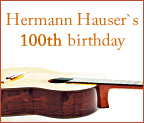
| History
Also in 1875, he established his own zither
music publishing house, in order to be able to self-publish his compositions
in folk music. After marrying a potter´s daughter,
Josef Hauser moved to Munich,
including his workshop and In 1898 Joseph Hauser was awarded the great
medal at the Common Music Exposition in Berlin, and Duke Maximilian
of Bavaria presented him the medal for Art and Science. |
German guitar manufacturer Hermann Hauser I, son of Josef Hauser, holds a leading position among luthiers worldwide. He learned the art of building instruments in his father´s workshop. Later on, he took over the workshop, while his father still managed the music publishing house. Hermann Hauser I specialized in building lutes and guitars, but also abode by making zithers. In the range of the Guitarist Movement in Bavaria, Hermann Hauser I built a variety of different guitars, especially the Vienna models and the Munich models in all kinds of forms, but all in absolute perfection. The Terz, Prim, and the very rare Quintbass guitars of Hermann Hauser I are of superior quality. The sound of these instruments is unrivaled even today. Based on his special virtuosity Hermann Hauser I developed technical, patented innovations concerning the construction of covers and corpus-neck connections. The Spanish virtuosi Miguel Llobet and Andres Segovia took notice of Hermann Hauser I´s art of manufacturing guitars at the beginning of the 20th century. The meeting of these precursors and masters of their trade around the turn of the century may well be called a magic moment in the history of guitars. Dr. Karl Huber wrote on this: Just like Antonio De Torres, Hermann Hauser I has influenced many 20th century luthiers. It goes without saying that his guitars have been played and are being played by many virtuosi and stars. In the Hauser family guest book you can find out about the intensive relations between luthier Hermann Hauser I and a variety of guitarists. These relations are reflected in the specific labeling of Hauser guitars, such as Llobet model, Segovia model and Bream model. The Hermann Hauser I guitar which was played by Andres Segovia between 1937 and 1970, can be viewed in the Metropolitan Museum of Art in New York now. In consequence of the heavy bomb attacks
on Munich, which caused considerable damage to the Hauser family
estate, Hermann Hauser I set up his workshop for instrument manufacturing
in Reisbach/Vils, which is in Lower Bavaria. |
Hermann Hauser II especially continued to develop Hermann Hauser I´s classical instruments and defined specific forms through intensive relationship with guitar virtuosi. His guitars were ordered by the same virtuosi that already played his father´s guitars, and by artists living in Hermann Hauser II´s present. Based on tradition and the collaboration with his father, this is how exquisite advancements and new developments evolved. Just like his father did, Hermann Hauser II cultivated the personal and amicable relations to guitarists. Andres Segovia, Julian Bream, Django Reinhart and many others highly appreciated the hospitality and the instruments of Hermann Hauser II. One of his most important instruments was
manufactured in 1957. Julian Bream played this instrument from 1959
to 1963, and in the year of 1960, he recorded music of Albeniz, Scarlatti,
Berkley, Rodrigo, Frescobaldi, Ravel and Rousell with it. You can
listen to this guitar on a record of the edition “The Art of
Julian Bream“. |
Hermann Hauser III consequently continues his great ancestors´philosophy. “Only build few instruments, so that you can vouch for each single instrument, and only work for few, but content artists”. (Hermann Hauser I). Beginning in 1974, Hermann Hauser III and
his father built guitars independently in the same workshop.
Hermann Hauser III provided
his instruments with his own numbering and signature. Andres Segovia
attested guitars of Hermann Hauser III undescribably beautiful sounds,
and Pepe
Romero simply calls his Hauser guitar the classical guitar
with the purest sound. The secret of the sound of a Hauser guitar
is to be found not only in technical processing. Just like his ancestors,
Hermann Hauser III cultivates the personal and amicable relations
to
his guitarists. Depending on the artists´ wishes, he tunes his guitars
to specific sound frequencies. Before constructing neck profiles
and finger boards, and before determining the length of the strings,
there´s a deep analysis of the artist´s needs and demands. It is
fundamental, that Hermann Hauser III spends time on studying historical
instruments, especially those of his ancestors. From this, both supreme
works of restoration of historic guitars and new development of special
limited editions, emerge. For his work, Hermann Hauser III received
highest awards from professional organisations and highest acknowledgement
of the international guitar community. In order to build guitars
at a level of highest perfection, he counts on: sure instinct, especially
for the guitarist´s
way of playing, a feeling for forms, to give musical aesthetics to the instruments,
handcraft talent, to correctly process the living resource wood, musicality,
to recognize the sonority of the instruments, and, above all: love for the
profession.
|